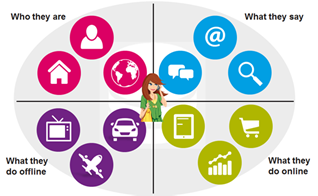Marketers have never been able to learn so much about their audience as they can now. The increasing volume of data that people are creating on a daily basis, can serve as an ideal starting point for brands to perfect their consumer engagement. Running concurrently with this, there is pressure from consumers demanding a better and more personalised customer experience. As a result, marketers who take the time and effort to truly understand and find their perfect audience are able to differentiate themselves in a highly competitive marketplace.
We all know it’s crucial to give our customers what they want and provide the most appropriate experience for every individual. A happy customer is a loyal customer and, of course, a potential advocate. In a digital world driven by online feedback and reviews, consumer advocacy has never been more important. Unhappy customers are inclined and able to broadcast their dissatisfaction to the world, potentially causing real damage to a brand in the process.
The basic truth underpinning marketing in a digital environment is that brands need to be able to know who their customers are in order to find them, reach them and communicate with them more effectively. The same thing goes for existing customers as it does for prospects. Recent Experian research found that 89% of marketers have trouble achieving a Single Customer View, and that gives you a good indication about the size of the challenge.
Understanding your audience is critical to be able to tailor your communication to fit their needs as well as reach your own goals. What better way to do this than knowing who your perfect customers are, where you can find them and how you can reach them? I do believe that effective marketing has the capacity to delight customers by demonstrating a real understanding of what they love. But how this can be done?
Everything begins with data
Today, everything starts with the data. Data-driven marketing enables accurate campaigns – based on real insights, rather than relying on intuition and instinct. There are a multitude of channels available for use, each with its own characteristics and pros and cons. Social media, PPC, TV, SMS, email, and display advertising – to name but a few. However, the accuracy and efficiency of these channels is very reliant on the data that drives them. Having inaccurate or disparate data severely impacts the effectiveness of every channel. Essentially there’s little point in investing in channels if the data you have driving them isn’t sufficient quality.
Linking data sets – the importance of first and third party data
The most important source of information is a brand’s first party data, considered as one of the most valuable assets of a company. It provides information on who their customers are, as well as on where, when and how they have interacted with the brand. In order to be able to build on this ‘gold mine’ of information, the quality and quantity of it is crucial. By building a strong view and understanding of all existing customers, it is possible to draw conclusions, patterns and trends to base future marketing decisions on.
Once the groups are defined you can look to understand where to engage them online and offline. This is where third party data comes into play – the right set of data can enable marketers to find new customers by seeing who visit their competitors’ websites or find new groups that might be interested in products they are developing.
Understand your audience
Differentiating between various consumer types, and especially locating them, relies entirely on a marketer’s ability to understand their characteristics and behaviour fully.
The multitude of signals useful to analyse when determining a brand’s audience, can be classified into four main types and all of them should be reckoned with when attempting to identify the ideal customers:
- Who they are – Demographic data such as their age and location, including household income, family situation and property. A good source of information can be consumer and demographic data.
- What they say – Search history, channel preferences and responses to interactions. Sources include web analytics, email responsiveness and social media signals.
- What they do offline – Lifestyle and attitudinal signals such as the types of brands they prefer or where they like to shop. Likes and dislikes – what media they consume (newspapers, TV stations). Consumer and demographic data usually can contain this information.
- What they do online – Online behaviour such as sites visited, actions and purchases on web pages. Useful sources can be web analytics, email behaviour, device analytics and path to purchase data.
So, only when a brand has a strong and reliable dataset, and a thorough understanding of who its customers are, should you start to think about creating a detailed marketing plan. Through powerful insights they will be able to build greater connections with their customer and create the kind of meaningful interactions that today’s demanding consumers expect.






